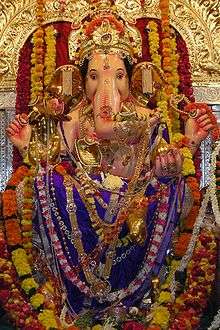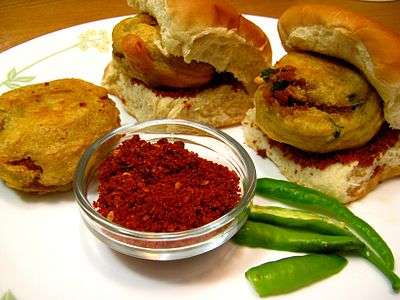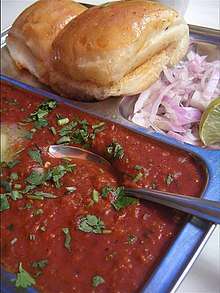Culture of Maharashtra
Maharashtra is the third largest state of India.It has a long history of Marathi saints of Varakari religious movement, such as Dnyaneshwar, Namdev, Chokhamela, Eknath and Tukaram which forms the one of bases of the culture of Maharashtra or Marathi culture.[1] Maharashtra had huge influence over India in 17th-century King Chatrapati Shivaji Maharaj of Maratha Empire and his concept of Hindavi Swarajya which translates to self-rule of people.[2]

The state of Maharashtra spans multiple cultures which includes cultures related to Hindus, Muslims, Buddhists, Sikhs, Christians, etc. Lord Ganesha, Maruti, Mahadeo in form of Shivlinga, Khandoba , Devi, and Lord Vitthal are some of the deities worshipped by Hindus of Maharashtra.
Maharashtra is divided into various regions, such as Marathwada, Vidarbha, Khandesh, and Konkan. Each has its own cultural identity in the form of different dialects of Marathi language,[3] folk songs, food, and ethnicity.
Overview


About 79% of Maharashtrians are Hindu, and there are significant Muslim, Christian and Buddhist minorities.[4] The Maharashtrian culture consists of people from all a vast majority of religions. Due to it being huge areawise, many sub-regional cultures also exist in Maharashtra. The sub region of Vidarbha, was earlier a part of Madhya Pradesh, hence it has that influence upon its culture.[5] There are many temples in Maharashtra, some of which are thousands of years old. These temples are constructed in a fusion of architectural styles borrowed from North and South India. The temples also blend themes from Hindu, Buddhist and Jain cultures. The temple of Vitthal at Pandharpur is the most important temple for the Varkari sect. Other important religious places are the Ashtavinayaka temples of Lord Ganesha, Bhimashankar which is one of the Jyotirling (12 important Shiva temples).[6][7]
Near Aurangabad are UNESCO World Heritage Sites and famous tourist attractions.[8][9] Mughal architecture can be seen in the tomb of the wife of Aurangzeb called Bibi Ka Maqbara located at Aurangabad.[10] Mumbai is the capital of Maharashtra and has humid climate throughout the year. The Gateway Of India, Chhatrapati Shivaji Terminus, Shaniwar Wada, Agakhan Palace and Deekshabhoomi are some of the historical monuments.
Maharashtra has a large number of hill, land and sea forts. Forts have played an important role in the history of Maharashtra since the time of the Shivaji Maharaj. Some of the important forts in Maharashtra are Shivneri, Raigad, Vijaydurg, Pratapgad, Sinhagad. The majority of the forts in Maharashtra are found along the coastal region of Konkan and the adjoining Sahyadri ranges.[11]
Religions, castes and sects
Marathi Hindus revere many religious figures. Among the figures who originated in the region are Banka Mahar, Bhagu, Damajipanth, Kanhopatra, Karmamelam, Nirmala, Sadna, Sakhubai, Satyakam Jabali and Soyarabai.[12]
Lifestyle
The people of Maharashtra have a rich traditional heritage.Maharashtrians have a very simple life style and believe in hard working. The Marathas of the state do not believe in having too many spacious palaces and mansions in-fact these people have lived a hard life and were inclined towards freedom struggle. The rustic lifestyle of the people can also be observed in the country-side of the state where people have a belief on universal cult of brotherhood, where the people of all religions lives as a one community. A place where the revered saints like Sai Baba, Osho and Haji Ali preached the religion of peace and prosperity. The people of the state wear different colorful types of costumes, and there is variation in dance and music according to people's specific localities. Dance forms like Powada, Banjara Holi Dance, Lavani, and Koli are popular in Maharashtra.[13]
Clothing
Traditional clothes for Maharashtrian males include the dhoti, also known as Dhotar, and pheta, while a choli and nine-yard saree locally known as Nauwari saadi or Lugda is for women. Traditional clothing is famous in rural areas while traditional people from cities also wear these clothing. These clothes are worn by Maharashtrians while performing various festivals.[14]
Cuisine


Marathi cuisine is the cuisine of the Marathi people from the Indian state of Maharashtra. It has distinctive attributes, while sharing much with other Indian cuisines. Traditionally, Maharashtrians have considered their food to be more austere than others.
Maharashtrian cuisine includes mild and spicy dishes. Peanuts and cashews are often served with vegetables. Meat was traditionally used sparsely or only by the well off until recently, because of economic conditions and culture.
Distinctly Maharashtrian dishes include pitla, bhakri, bharleli vangi, ukdiche modak, aluchi patal bhaji, Thalipeeth, pav bhaji, Puran Poli, Shrikhand, Basundi, vada pav, nashik chi misal pav, and Mumbai chaat. Puneri missal, nagpuri, sambar vada, and selucha chanaare also considered to have originated from Maharashtra.[15]
The Konkan, Varadi, Agri and khandeshi cuisines are popular with tourists. The specialty dishes of Maharashtran cuisines are often strong in pepper and spice with a twist of curry leaves, coconut and peanuts; well-known dishes include vada pav, misal pav and Mumbai chaat and puneri missal, selucha chana.[15]
Typical breakfast items include misal, pohe, upma, sheera, sabudana khichadi and thalipeeth. In some households leftover rice from the previous night is fried with onions, turmeric and mustard seeds for breakfast, making phodnicha bhat. Typical Western breakfast items such as cereals, sliced bread and eggs, as well as South Indian items such as idli and dosa are also popular. Tea or coffee is served with breakfast.
Urban lunch and dinner menus
A Maharashtrian vegetarian meal with a variety of items Vegetarian lunch and dinner plates in urban areas carry a combination of:
- Wheat flatbread such as round chapati or ghadichi poli (layered triangular chapati)
- Boiled rice
- Salad or koshimbir based on onions, tomatoes or cucumber
- Papad or related snacks such as sandge, kurdaya and sabudana papdya
- Dry or fresh chutney, mango or lemon pickles
- Aamti or varan soup based on toor dal, other dals or kadhi. When usal is part of the menu, the aamti may be omitted.
- Vegetables with gravy based on seasonal availability such as egg plants, okra, potatoes, or cauliflower
- Dry leafy vegetables such as spinach
- Usal based on sprouted or unsprouted whole legumes
Apart from bread, rice, and chutney, other items may be substituted. Families that eat meat, fish and poultry may combine vegetarian and non-vegetarian dishes, with rice and chapatis remaining the staples. Vegetable or non-vegetable items are essentially dips for the bread or for mixing with rice.
Traditional dinner items are arranged in a circular way. With salt placed at 12 o'clock, pickles, koshimbir and condiments are placed anti-clockwise of the salt. Vegetable preparations are arranged in a clockwise fashion with a sequence of leafy greens curry, dry vegetables, sprouted been curry (usal ) and dal. Rice is always on the periphery rather than in the center.
Rural lunch and dinner menus
A typical simple Maharashtrian meal with bhaaji, bhakari, raw onion and pickle In the Konkan coastal area, boiled rice and rice bhakri,nachni bhakri is the staple, with a combination of the vegetable and non-vegetable dishes described in the lunch and dinner menu.
In other areas of Maharashtra such as Desh, Khandesh, Marathwada and Vidarbha, the traditional staple was bhakri with a combination of dal, and vegetables. The bhakri is increasingly replaced by wheat-based chapatis.
Famous food joints in Maharashtra
- Shyam Sundar misal, (Nashik)
- Ashok Vada Pav, Dadar(Mumbai)
- 3.Sardar Pav Bhaji (Mumbai)
- Konkan Cafe, mumbai
- Maratha Samrat, Pune
Architecture
Sport
Sports is an important part of the culture of Maharashtra. Kabaddi, Hockey, Kho kho, Badminton, Cricket and Table tennis are the popular sports of Maharashtra.[16] The Sporting activities in Maharashtra are governed by the Commissionerate of Sports and Youth Servies, Pune. The wrestling championship like Hind Kesari, Maharashtra Kesari are very popular in the rural regions of Maharashtra.[17] The cricket craze can be seen throughout Maharashtra, as it is the most widely followed and played sport.[18] The Maharashtra has produced many Iconic cricketers to India like Sachin Tendulkar and Sunil Gavaskar.[17] Children games include Gilli-danda and Pakada-pakadi (tag) are also played in Maharashtra.Horse riding, Wrestling, Fencing, Archery and Shooting were popular among the rulers of Maharashtra.[16][19] Maharashtra has various domestic level Franchise based leagues for Hockey, Chess, Tennis and Badminton.
References
- "Sant Bhumi Maharashtra". Retrieved 21 November 2015.
- "Shivaji Maharaj, Founder and an Ideal ruler of Hindavi Swarajya". Retrieved 21 November 2015.
- "Languages in Maharashtra".
- "Maharashtra latest caste/religionwise population demographics". July 2016. Retrieved 15 September 2017.
- "Important facts about Vidarbha".
- "Temples of Maharashtra". Retrieved 15 September 2017.
- "Top 12 Shiva temples in Maharashtra". Retrieved 15 September 2017.
- "Ajanta Caves". Retrieved 15 September 2017.
- "Ellora Caves". Retrieved 15 September 2017.
- "Bibi Ka Maqbara". Retrieved 15 September 2017.
- "Top 25 monuments in Maharashtra". Retrieved 15 September 2017.
- Shepherd, P. 111 Gurus Rediscovered:
- "Folk dance forms of Maharashtra". Retrieved 15 September 2017.
- "Vidhi Jhaveri" (August 2017). "Traditional Maharashtrian dresses". Retrieved 15 September 2017.
- "Food diaries: Maharashtra food and cuisine". Retrieved 15 September 2017.
- "Sports of Maharashtra". Indfy.com. 2011-10-04. Archived from the original on 2013-11-01. Retrieved 2013-10-20.
- "Culture of Maharashtra - Sovereign Maharashtra". Maharashtramaza.info. Archived from the original on 2013-10-20. Retrieved 2013-10-20.
- "'Parallel Journeys' - Celebrating Indian cricket craze - CoolAge". Coolage.in. Archived from the original on 2013-10-20. Retrieved 2013-10-20.
- "History of Maharashtra". Scribd.com. 2010-11-20. Retrieved 2013-10-20.